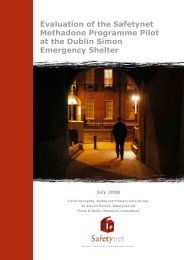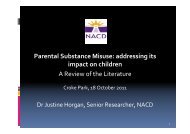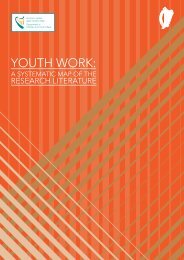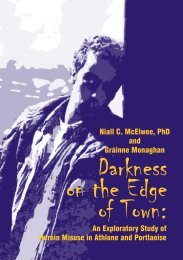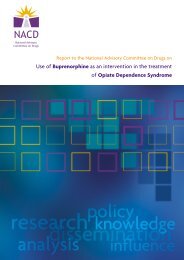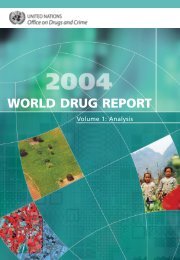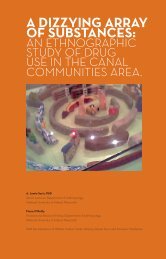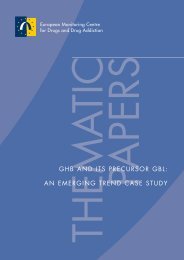Crack cocaine in the Dublin region - Health Research Board
Crack cocaine in the Dublin region - Health Research Board
Crack cocaine in the Dublin region - Health Research Board
You also want an ePaper? Increase the reach of your titles
YUMPU automatically turns print PDFs into web optimized ePapers that Google loves.
Table 4.4Number of new cases who lived <strong>in</strong> Dubl<strong>in</strong> and reported crack <strong>coca<strong>in</strong>e</strong> as a problemdrug, by accommodation status, as reported to <strong>the</strong> NDTRS, 2004 to 2006Accommodation status Number %Stable accommodation 21 60.0Unstable accommodation* 12 34.4Not known 2 5.7Total 35 100.0* Unstable accommodation <strong>in</strong>cludes prisons, halfway houses, homeless hostels, bed and breakfast, sleep<strong>in</strong>g rough andliv<strong>in</strong>g with friends on a temporary basis.Of <strong>the</strong> 24 drug-treatment and social services <strong>in</strong>terviewed who that had recentexperience of crack users, 16 had experience with homeless <strong>in</strong>dividuals us<strong>in</strong>g crack.A similar experience was reported by a drug-treatment service specifically target<strong>in</strong>g<strong>the</strong> homeless <strong>in</strong> <strong>the</strong> north-<strong>in</strong>ner city; it estimated that just under one-third of its clientswere us<strong>in</strong>g crack (15 users approximately).4.7 Key f<strong>in</strong>d<strong>in</strong>gs• The majority of crack users seek<strong>in</strong>g treatment had a history of problematic druguse (ma<strong>in</strong>ly <strong>in</strong>volv<strong>in</strong>g opiates). This was confirmed by data from drug-treatmentand social services.• The data from <strong>the</strong> NDTRS provide a profile of <strong>the</strong> 35 new cases who lived <strong>in</strong>Dubl<strong>in</strong> and reported crack <strong>coca<strong>in</strong>e</strong> as a problem drug between 2004 and 2006.Over half (51%) were aged between 20 and 29 years at <strong>the</strong> time <strong>the</strong>y commencedtreatment; 37.1% were over 30 years of age; and 37% had begun to use crackbefore <strong>the</strong> age of 20.• Accord<strong>in</strong>g to collated data from treatment sett<strong>in</strong>gs, approximately three outof every four crack users are male. Interviews with drug-treatment and socialservices suggested that <strong>the</strong> gender balance varied between <strong>in</strong>dividual services.• Several drug-treatment services reported that females <strong>in</strong>volved <strong>in</strong> sex work ands<strong>in</strong>gle mo<strong>the</strong>rs developed <strong>the</strong> most chaotic crack addiction.• A number of service providers reported that a proportion of crack <strong>coca<strong>in</strong>e</strong> usersmay be young people who b<strong>in</strong>ge on crack but do not engage with treatmentservices, primarily because <strong>the</strong>y do not view crack as harmful or <strong>the</strong>ir use asproblematic or do not want to be associated with <strong>the</strong> established opiate treatmentcentres. None of <strong>the</strong>se young people were available for <strong>in</strong>terview.• Education levels were low among crack users <strong>in</strong> treatment and homelessnesswas common<strong>Crack</strong> <strong>coca<strong>in</strong>e</strong> <strong>in</strong> <strong>the</strong> Dubl<strong>in</strong> <strong>region</strong>: an evidence base for a crack <strong>coca<strong>in</strong>e</strong> strategy57




